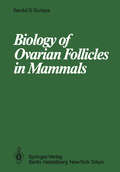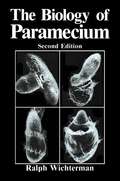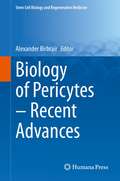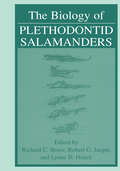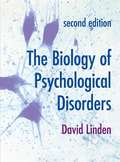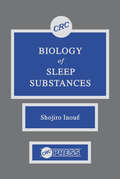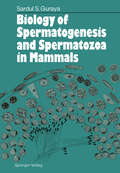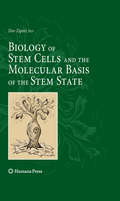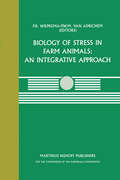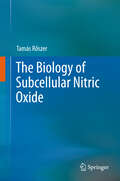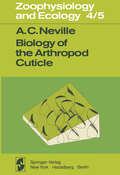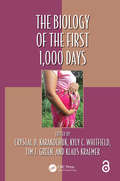- Table View
- List View
Biology of Ovarian Follicles in Mammals
by S.S. GurayaBoth functions of the mammalian ovary, the endocrine and (synthesis and secretion of steroid hormones) and exocrine (production of ova), depend upon the presence and cyclic growth of follicles, as the depletion of primordial follicles from the ovary leads to cessation of these f-unctions or female reproduction in mammals, or to postmenopausal period in humans. Actually, various fertility and sterility problems at the ovarian level are related to follicles. Therefore, a thorough understanding of the biology of ovarian follicles in mammals is of fundamental interest to a wide variety of academic and scientific disciplines. Study of their structure, function, and control involves mor phology, including ultrastructure, cell biology, physiology, endocrinology, biochemis try, immunology, neurobiology and pharmacology. Zoologists take interest in comparative and evolutionary aspects of biology of ovarian follicles in many different groups of mammals. Agricultural scientists and wildlife biologists need a thorough knowledge of the biology of follicles to control more effectively fecundity in domestic animals and endangered species of mammals. Finally, clinical scientists, toxicologists and physicians want to know the normal and pathological features of ovarian follicles in women, especially in relation to health and the regulation of fertility. Having in view the great importance of studying various aspects of biology of ovarian follicles, numerous papers and reviews on several aspects of ovarian follicles are published annually in a wide variety of scientific journals.
The Biology of Paramecium
by R. WichtermanThis completely revised, updated, and expanded edition has been neces sitated by the many important newer discoveries that have been made since the publication of the first edition. That volume contained almost 2000 references from the 1600s to 1953. Since then and after an extensive search, I have accumulated some 3800 additional titles from the world's literature on Paramecium. After certain titles that largely represented abstracts and preliminary reports that were followed by full research papers were eliminated, approximately 4400 full titles from the 1600s to the present were selected for inclusion in this edition. Most of the titles in the Bibliography are the more recent ones beginning with 1953. I consider the Bibliography an important part of the book: A good title of a paper in a journal is a minature abstract of its contents. Thus, the reader who may be interested in obtaining additional information not found in the book may refer directly to the original source. A cursory examination of the Bibliography will reveal that parame cium research has extended into all branches of biology, including bio chemistry and biophysics. Like other areas of science, paramecium research has become highly specialized and fragmented. I have attempted to organize and present the basic information in one book. Because of space limitations, some items may have been dealt with briefly. It is in such instances that the Bibliography will be found to be invaluable.
The Biology of Parasites
by Richard Lucius Brigitte Loos-Frank Richard P. Lane Robert Poulin Craig Roberts Richard K. GrencisThis heavily illustrated text teaches parasitology from a biological perspective. It combines classical descriptive biology of parasites with modern cell and molecular biology approaches, and also addresses parasite evolution and ecology. Parasites found in mammals, non-mammalian vertebrates, and invertebrates are systematically treated, incorporating the latest knowledge about their cell and molecular biology. In doing so, it greatly extends classical parasitology textbooks and prepares the reader for a career in basic and applied parasitology.
The Biology of Parasites
by Richard Lucius Brigitte Loos-Frank Richard P. Lane Robert Poulin Craig Roberts Richard K. GrencisThis heavily illustrated text teaches parasitology from a biological perspective. It combines classical descriptive biology of parasites with modern cell and molecular biology approaches, and also addresses parasite evolution and ecology. Parasites found in mammals, non-mammalian vertebrates, and invertebrates are systematically treated, incorporating the latest knowledge about their cell and molecular biology. In doing so, it greatly extends classical parasitology textbooks and prepares the reader for a career in basic and applied parasitology.
Biology of Parasitism
by Christian Tschudi Edward J. PearceBiology of Parasitism is based on the Biology of Parasitism Course at the Marine Biological Laboratory in Woods Hole, Massachusetts. Having just celebrated its 20th offering, this Course has distinguished itself as the premier, world-renowned training ground for future generations of parasitologists. The primary goal of the Course is to attract and introduce the very best and most promising young researchers to the many unresolved problems in parasitology and prepare them for their future as independent investigators in the field. The rigorous program combines state-of-the-art laboratory research with a program of visiting lecturers who bring together the most current research in the field. Since at this time there are no academic institutions that have enough depth in parasitology research or teaching faculty to provide up-to-date and state-of-the-art training, the Course has become, and will remain, a global resource for providing intensive education in modern parasitology. Biology of Parasitism is intended to present a snapshot of the content and spirit of the Biology of Parasitism Course. By presenting a series of chapters that reflect the formal lectures that students receive on a daily basis, as well as the approaches used during the laboratory section of the Course, the editors hope to share some of the science that occurs there. One part of the book presents the experimental component of the Course, in particular the subject matter of the four two-week sessions covering Immunology, Biochemistry, Cell Biology and Molecular Biology of protozoan and helminth parasites. As in the Course, the experimental part is complemented by a number of review-like chapters solicited from the large number of speakers who lecture during the Course.
Biology of Pericytes – Recent Advances (Stem Cell Biology and Regenerative Medicine #68)
by Alexander BirbrairPericytes were originally discovered and named more than hundred years ago as contractile cells around the blood vessel endothelial cells. Due to the lack of exclusive markers, pericytes are now defined by a combination of location, morphology and gene expression. Pericytes are attracting increasing attention as important regulators during development and during normal and disturbed organ function. In recent years, remarkable progress has been made in the identification and characterization of pericytes subpopulations and their amazing functions using state-of-art techniques. These advantages facilitated identification of molecular basis of interaction between these cells with several other more well studied cell types, and revealed key signals derived from pericytes involved in homeostasis, regeneration, and disease regulation. In the last ten years, several unexpected roles of pericytes have been discovered. It has been demonstrated that pericytes from different tissues differ in their properties as well as functions. Even more, pericytes are heterogeneous also within the same organ. This book is will describe the major contributions of pericytes to different organs biology in physiological and pathological conditions.The book will teach the readers about this so special cell type that 10 years ago was almost completely forgotten, and it was associated basically only with vascular stability. Recently, it become a very hot topic to work in. Several articles in Nature, Science and Cell have been and are being currently published about this cell type. These recent works are revealing how important those cells are for before unimaginable biological processes.Thus, this book will update us on what are the most novel functions attributed to these cells. Also, will introduce to the young generation all the history about these cells from when they were discovered in different organs till where we are now in this field. So it will be a great book for both cell biology students as well as researchers that will have an update on these cells biology in different organs.
The Biology of Plethodontid Salamanders
by Richard C. Bruce Robert G. Jaeger Lynne D. HouckThis volume offers a state-of-the-art overview of plethodontid salamanders. Readers will find the best current understanding of many aspects of the evolution, systematics, development, morphology, life history, ecology, and field methodology of these animals.
Biology of Poxviruses (Virology Monographs Die Virusforschung in Einzeldarstellungen #18)
by Samuel Dales B.G.T. PogoThis volume, Biology of Poxviruses, marks our debut as editors of this well known series. We plan to continue the tradition of providing a forum for exten sive, critical reviews of individual virus groups, as exemplified by the present volume. But the pace of discovery is accelerating so rapidly that we feel the need to offer an additional format: volumes that contain collections of shorter, topical reviews on a group of related subjects. Such collections might cut across con ventional boundaries between virus groups, dealing, as an example, with a partic ular aspect of virus-cell interaction. Admittedly, this new format stretches the term "monograph" beyond the accepted definition, but we believe that we should pay that price to maintain the usefulness of the series as a medium of scientific communication. Whenever possible, we will enlist the aid of deputy editors to bring such col lections to fruition. As in the past, the editors and the publisher will welcome suggestions for topics and contributions.
The Biology Of Psychological Disorders (PDF)
by David LindenPsychological disorders – their origins, clinical symptoms and treatment – have a central place in contemporary public health debate. Understanding how disruptions in the brain's biological mechanisms can influence our thoughts, feelings and actions is one of the most exciting challenges for psychologists in the twenty-first century. The Biology of Psychological Disorders is an authoritative account of some of the most prevalent psychological disorders, from schizophrenia, depression, mania and substance abuse to disorders of childhood, adolescence and ageing. Detailed and engaging coverage of these disorders is combined with a comprehensive grounding in the fundamentals of neuroscience and the principles of psychopharmacology that underpin their treatment. Drawing on the fields of psychology, psychiatry, neuroscience and biology, this highly relevant text is an invaluable resource for students of biological psychology and psychopharmacology, trainee psychiatrists and anyone interested in understanding, researching and treating psychological disorders.
Biology of Renal Cell Carcinoma
Biology of Renal Cell Carcinoma presents the proceedings of the Third International Symposium on the Biology of Renal Cell Carcinoma, March 1994. This symposium gathers "internationally acclaimed researchers from relevant fields of renal cell carcinoma to present their latest work and to interact on the interpretation of these findings and direction for subsequent studies. The program is directed to physicians and research scientists involved in the clinical and basic research aspects of the treatment of renal cell carcinoma." (from the Symposium Announcement)Topics covered in the areas of Molecular Biology of Renal Cell Carcinoma: Cytogenetics, Genetic Approaches to Therapy of Renal Cell Carcinoma, Immunology of Renal Cell Carcinoma - T-Cell Anergy, New Approaches with Renal Cell Carcinoma - Cytokines.
Biology of Salmonella (Nato Science Series A: #245)
by Filipe Cabello Carlos Hormaeche Pasqale Mastroeni Letterio BoninaSalmonella infections of man and animals continue to be a distressing health problem worldwide. Far from disappearing, the incidence of typhoid fever in developing countries may be far higher than we had imagined. Salmonella food poisoning has increased to one of the major causes of gastroenteritis in the developed world, in itself also an indication that animal salmonellosis is still a major cause for concern. The situation requires a concerted multidisciplinary research effort in order to generate the new information and technology needed to assist in the control of these diseases. This concept was the driving force behind the NATO Advanced Research Workshop on "Biology of Salmonella" held at Portorosa, Messina, Italy, May 11-15, 1992. With additional support from the University of Messina, Medeva Group Research (UK) and the Swiss Serum and Vaccine Research Institute, the meeting brought together epidemiologists, microbiologists, molecular biologists, immunologists and clinicians. All the participants were actively working on different but related aspects of Salmonella and salmonellosis, with most of the leading laboratories worldwide being represented. The workshop provided an excellent opportunity for interdisciplinary consultation; it is not often that the topic of Salmonella and salmonellosis is covered to such breadth and depth in one extended meeting. Keynote addresses by invited speakers were interspersed with offered papers, many by younger members of the scientific community, and this volume presents the collated manuscripts of the lectures and extended summaries of the offered papers.
The Biology of Senescence: A Translational Approach (Practical Issues in Geriatrics)
by Bernard SwynghedauwThis book describes the fundamental process of senescence, and reviews a new concept developed by a number of research groups that is based on cellular senescence and its secretome. This concept provides a basic explanation of the main physiological and pathological features of senescence, and delineates possibilities for “treating” it. Following an introduction to the emerging medical landscape, the increasing incidence of a new epidemiological group (age-related “chronic non-transmissible diseases”), and the multiple origins of aging, the book explores and characterizes the senescent cell, which is linked to benign and pathological age-related manifestations. In turn, the closing chapters discuss how to “treat” or “prevent” the aging process, underscoring the central role of physical exercise and caloric reduction as compared to new senolytic approaches. Appendices are also provided, and address circadian rhythms, telomere shortening, diabetic cardiomyopathy, and senescence in plants and bacteria. Given its scope, the book will primarily be of interest to geriatricians, but will also appeal to a wider range of clinicians.
Biology of Sensory Systems
by C. U. SmithSince publication of the first edition, huge developments have taken place in sensory biology research and new insights have been provided in particular by molecular biology. These show the similarities in the molecular architecture and in the physiology of sensory cells across species and across sensory modality and often indicate a common ancestry dating back over half a billion years. Biology of Sensory Systems has thus been completely revised and takes a molecular, evolutionary and comparative approach, providing an overview of sensory systems in vertebrates, invertebrates and prokaryotes, with a strong focus on human senses. Written by a renowned author with extensive teaching experience, the book covers, in six parts, the general features of sensory systems, the mechanosenses, the chemosenses, the senses which detect electromagnetic radiation, other sensory systems including pain, thermosensitivity and some of the minority senses and, finally, provides an outline and discussion of philosophical implications. New in this edition: Greater emphasis on molecular biology and intracellular mechanisms New chapter on genomics and sensory systems Sections on TRP channels, synaptic transmission, evolution of nervous systems, arachnid mechanosensitive sensilla and photoreceptors, electroreception in the Monotremata, language and the FOXP2 gene, mirror neurons and the molecular biology of pain Updated passages on human olfaction and gustation. Over four hundred illustrations, boxes containing supplementary material and self-assessment questions and a full bibliography at the end of each part make Biology of Sensory Systems essential reading for undergraduate students of biology, zoology, animal physiology, neuroscience, anatomy and physiological psychology. The book is also suitable for postgraduate students in more specialised courses such as vision sciences, optometry, neurophysiology, neuropathology, developmental biology. Praise from the reviews of the first edition: "An excellent advanced undergraduate/postgraduate textbook." ASLIB BOOK GUIDE "The emphasis on comparative biology and evolution is one of the distinguishing features of this self-contained book. .... this is an informative and thought-provoking text..." TIMES HIGHER EDUCATIONAL SUPPLEMENT
The Biology of Skeletal Metastases (Cancer Treatment and Research #118)
by Evan T. Keller and Leland W. K. Chung- National Cancer Institure Budget is encouraging research in order to develop a better understanding of metastasis of cancer to the bone - Provides the reader with comprehensive reviews written by well known experts on related topics
Biology of Sleep Substances
by Shojiro InoueAll aspects of sleep sciences are included in this excellent resource text, with special reference to sleep substances and sleep modulators. The historical development of the theories of sleep are reviewed in conjunction with the technical problems. All candidate substances are overviewed as to their sites of presence, chemical nature, bioassay techniques, physiological and pharmacological effects. On the basis of a standardized methodology developed by the author, sleep-modulatory characteristics of some substances are compared and evaluated in quantitative terms. The sleep regulatory mechanisms, which are composed of complex neurohumoral subsystems, are analyzed from the results of recent neurophysiological and neuroendocrinological experiments. Furthermore, an evolutionary aspect of sleep substances is taken into consideration.Chapters Highlight:Techniques for isolation and evaluationProstaglandinsParadoxical sleep factorsSleep-promoting substances and nucleosides
Biology of Sleep Substances
by Shojiro InoueAll aspects of sleep sciences are included in this excellent resource text, with special reference to sleep substances and sleep modulators. The historical development of the theories of sleep are reviewed in conjunction with the technical problems. All candidate substances are overviewed as to their sites of presence, chemical nature, bioassay techniques, physiological and pharmacological effects. On the basis of a standardized methodology developed by the author, sleep-modulatory characteristics of some substances are compared and evaluated in quantitative terms. The sleep regulatory mechanisms, which are composed of complex neurohumoral subsystems, are analyzed from the results of recent neurophysiological and neuroendocrinological experiments. Furthermore, an evolutionary aspect of sleep substances is taken into consideration.Chapters Highlight:Techniques for isolation and evaluationProstaglandinsParadoxical sleep factorsSleep-promoting substances and nucleosides
Biology of Stem Cells and the Molecular Basis of the Stem State (Stem Cell Biology and Regenerative Medicine)
by Dov ZiporiBiology of Stem Cells and the Molecular Basis of the Stem State concentrates upon adult stem cells, particularly on mesenchymal cell populations, which is the author’s area of expertise. The text offers the reader a detailed description of the emergence of stem cell research and the dogmas that were created during the first decades of analysis of stem cell properties, particularly those of hemopoietic stem cells. Biology of Stem Cells and the Molecular Basis of the Stem State also introduces the reader to the commonly accepted notions regarding stem cell biology, with an emphasis on an alternative view of stemness, i.e. the stem state. In keeping with the popularity of this topic, Biology of Stem Cells and the Molecular Basis of the Stem State addresses the major controversies and points of dispute, among researchers in the stem cell field. Overall, Biology of Stem Cells and the Molecular Basis of the Stem State presents a well-rounded dialogue about stem cells as it not only concentrates upon the biological elements of stem cell, but also addresses the controversy and hype currently enveloping this popular subject.
Biology of Stress in Farm Animals: A seminar in the CEC programme of coordination research on animal welfare, held on April 17–18, 1986, at the Pietersberg Conference Centre, Oosterbeek, The Netherlands (Current Topics in Veterinary Medicine #42)
by Lee S. CohenThis book contains the contributions to a workshop on stress in farm animals held on April 17-18,1986 at the Pietersberg Con ference Centre Oosterbeek. The workshop was financed by the Commis sion of the European Communities from its budget for the coordina tion of Community Agricultural Research and the Agricultural Uni versity of Wageningen (The Netherlands). Its aim was to bring together experts from different disciplines all having in common that in one way or another they were involved in stress research. Such a multidisciplinary encounter should not only provide an interesting description of present day knowledge on stress, but also promote a more integrated view on stress phenomena as they occur in higher vertebrates. In the course of this workshop the following fields of research were related to stress: endocrinology, immunology, pathology, neurobiology, ethology and theoretical bio logy. Each of these relationships was introduce& by one speaker presenting a concise state of the art. The same relationship was elaborated by a second speaker implementing the available knowledge as far as possible to the farm animal situation. Therefore in this book each discipline is represented by a duo and introduced by some integrating remarks.
The Biology of Subcellular Nitric Oxide
by Tamás RőszerThis book fills in a gap in the NO literature. Recent progress in the field of NO-biology shows that NO is generated within distinct cell compartments, including specific plasma membrane regions, mitochondria, chloroplasts, peroxisomes, the Golgi-complex and intracellular membrane systems. NO synthesis plays specific roles in these compartments and, in turn, cell organelles also control intracellular NO levels. This monograph focuses on the roles played by the subcellular NO-signaling microdomains in the prokaryote-, fungus-, plant- and animal cells and shows how NO behaves as an intracellular signal in distinct cellular environments. This monograph also provides a summary of our knowledge on how NO synthesis came through evolution to be associated with organelles and subcellular compartments. Promotes the novel ideas that some functions of NO and its associations with subcellular units have been conserved during the evolution of the cell. A special chapter is dedicated to the biomedical relevance of subcellular NO synthesis, and this chapter also discusses the evidence that altered compartmentalization of NO-producing enzymes causes disease.
The Biology of Taurine: Methods and Mechanisms (pdf) (Advances in Experimental Medicine and Biology #217)
by Ryan J. Huxtable F. Franconi A. GiottiBiology of the Arterial Wall (Basic Science for the Cardiologist #1)
by Bernard I. Levy Alain TedguiBiology of the Arterial Wall is intended as a general reference text concerned with the biology of the vascular cells and the blood vessel wall under physiological and pathological conditions. One of the major functions of the arteries is to maintain a continuous blood flow to the organs whatever the pressure conditions, thanks to the vasomotor tone of the smooth muscle cells. Great advances have been made over the last decade in the understanding of the endothelial cells as integrators and transducers of signals originating from the blood stream. The pluripotent control functions of the endothelial cells in the vessel wall are now well recognized. A review of endothelial functions and dysfunctions is presented. Cell biology and molecular genetic studies have now identified an array of molecules elaborated by endothelial cells and vascular smooth muscle cells and by the blood-borne elements which interact with artery cells, defending the artery against injury and modulating evolving abnormal processes. Molecules which induce or inhibit endothelial and/or smooth muscle cells are currently under great scrutiny. Angiogenesis, which plays a major role in tumor growth, but may also be beneficial as a healing process in muscle ischemia, is discussed. Apoptosis, or programmed cell death, has only recently been recognized as an essential process in blood vessel modeling and remodeling. An overview of apoptosis in the vascular system is presented. It is increasingly evident that the adjustments of the blood vessel wall are made in the presence of deforming disease processes such as hypertension and atherosclerosis. The second part of the book is concerned with the blood vessel wall in disease conditions. Several chapters review the role of the vessel and vascular cells in inflammation, and vascular remodeling during arterial hypertension and aging. One chapter is devoted to atherogenesis, atheroma and plaque instability, followed by the pathophysiology of post-angioplasty restenosis, which is a crucial issue in modern interventional cardiology.
Biology of the Arthropod Cuticle (Zoophysiology #4/5)
by A.C. NevilleMention the words 'arthropod cuticle' to most biologists and they usually provoke a glazed expression. This is because the cuticle is commonly regarded as an inert substance. It is hoped that this book will dispel this fallacy. The study of cuticle in its proper context now involves many of the wider aspects of biology which are currently in vogue (e. g. how a hormone like ecdyson induces a specific enzyme like dopa decarboxylase; the unsolved major problem of cell gradient and polarity; the involvement of cyclic AMP in hormonal mechanisms; the extra cellular control of cuticular enzymes, of the mechanical proper ties of cuticle structural proteins, and of the orientation of fibrous molecules; and the relation of chromosome puffing to the synthesis of specific proteins). Studies on cuticle demand a variety of techniques, and examples of the following are illustrated in this book (fluorescence, phase contrast, polariza tion and Nomarski interference microscopy; infrared absorp tion; transmission and scanning electron microscopy; autora diography analyzed by electron microscopy; negative staining in the electron microscope; optical diffraction, high angle X-ray diffraction, low angle X -ray diffraction and selected area electron diffraction). I am well aware that the biophysical parts of this book are less incomplete than other aspects. A developmental biologist or a biochemist would have further elaborated other parts ofthe subject matter. Only one previous author, RICHARDS (1951)hasdevoted a book to arthropod cuticle.
The Biology of the First 1,000 Days (Oxidative Stress and Disease)
by Crystal D. Karakochuk Kyly C. Whitfield Tim J. Green Klaus KraemerThe first 1,000 days, from conception to two years of age, is a critical period of growth and development. Exposures to dietary, environmental, hormonal, and other stressors during this window have been associated with an increased risk of poor health outcomes, some of which are irreversible. The book addresses this crucial interval of early life across biological disciplines, linking concepts related to all biological fields to outcomes during the first 1,000 days (e.g. fetal growth and pregnancy outcomes) and beyond (e.g. gut microbiome and cardiovascular disease later in life). The strength of this book lies in its cross-disciplinary nature.
The Biology of the First 1,000 Days (Oxidative Stress and Disease)
by Crystal D. Karakochuk Kyly C. Whitfield Tim J. Green Klaus KraemerThe first 1,000 days, from conception to two years of age, is a critical period of growth and development. Exposures to dietary, environmental, hormonal, and other stressors during this window have been associated with an increased risk of poor health outcomes, some of which are irreversible. The book addresses this crucial interval of early life across biological disciplines, linking concepts related to all biological fields to outcomes during the first 1,000 days (e.g. fetal growth and pregnancy outcomes) and beyond (e.g. gut microbiome and cardiovascular disease later in life). The strength of this book lies in its cross-disciplinary nature.
